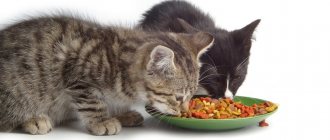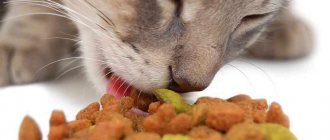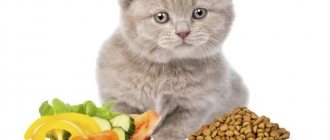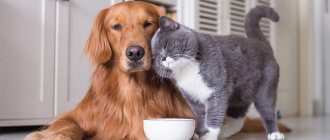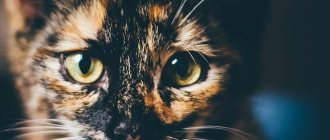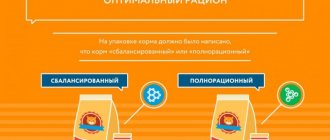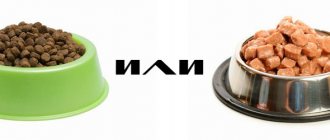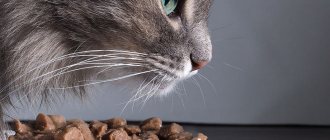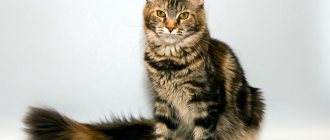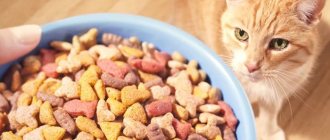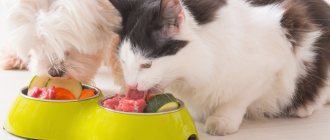It is no secret for cat owners that good, high-quality food is quite expensive. However, you need to feed the cat every day, and saving money on food can cost the animal its health, or even its life. Sometimes the owner makes the mistake of treating the cat to food from his table. It should be remembered that human food, richly flavored with seasonings, spices, sometimes fatty or too spicy, is not suitable for a cat. What to do in this case, only the owner of the animal must decide, but the choice is not so great: food prepared for the cat with his own hands or purchasing commercial food (dry or wet food). Probably, the first option is better and more reliable, because the owner knows what quality of products he bought and how he prepared them. But in terms of saving time, this option is not the best - a person who is busy most of the day is unlikely to be able to spend so much time cooking for a cat. If you are considering purchasing dry and wet food, you should first carefully study the composition of the product, read customer reviews, and ideally, consult a doctor.
Ready-made food versus homemade food
A properly formulated diet is the key to the health of your pet.
Pet breeders are divided in their opinions regarding the proper feeding of cats and kittens.
Some argue that the animal should be given only natural products without “store food”; others argue that a homemade diet does not contain those beneficial additives that are included in industrial food.
It really doesn’t matter what kind of food a breeder gives his pet –.
The main criterion is a balanced diet.
The diet should contain:
- vitamins and minerals;
- macro- and microelements;
- proteins;
- fats;
- carbohydrates.
Ready-made meals have a number of advantages:
- The owner does not waste time preparing food. Industrial feed is sold in packs or small packages that are designed for one use.
- Dry food can be left for several days. It does not deteriorate and is a “lifesaver” in case of a long absence of the breeder.
- Luxury and holistic food contains all the components necessary for proper nutrition of the pet.
- A wide range of products will allow the owner to choose food specifically for his animal, based on individual needs. There are lines of food for cats of different ages, sterilized pets, lactating cats, animals with various diseases, excess weight, etc.
The disadvantages include the pricing policy . High-quality food of premium class and higher costs more than natural food. Buying economy class food is strictly not recommended. They negatively affect the health of your pet.
Pregnant cat
Proper nutrition for cats when bearing kittens is the key to impeccable health of the future offspring. Since during this period the animal becomes especially picky about food, it is better to switch it to elite dry food, specially designed for expectant mothers. Such nutrition of a pregnant cat will replenish the deficiency of vitamins, strengthen the body, prepare it for the upcoming labor, and will not allow the animal to gain much weight. You can cook food yourself, but give preference to lean varieties of meat and fish, steamed or boiled.
What is a natural diet?
Natural diet - balanced nutrition
Natural diet - balanced nutrition , which includes meat and fish products, eggs, boiled vegetables, milk and dairy dishes.
Such nutrition is necessary for the full development of the cat. Thanks to these products, the body receives micro- and macroelements, calcium, protein, vitamins and minerals.
Basic diet
The basis of nutrition is natural meat, fish and fermented milk products.
Main dishes:
- Meat, offal and fish. To prepare meat dishes, you should choose low-fat varieties, namely: beef, rabbit, chicken, veal. Of the by-products, light ones are especially popular, but they should be given in small portions, after boiling for 2-3 minutes. Many breeders buy beef tripe, but it needs to be stored in the freezer for several days before using it.
- Boiled eggs. An adult pet needs 1-2 eggs per week.
- Dairy products. They are necessary for the animal to improve the functioning of the digestive system, and also saturate the body with calcium. Fresh milk is difficult to digest; it should be given several times a week in small portions.
- Boiled vegetables. They saturate the pet's body with fiber. If the animal refuses to eat them in their pure form, the product is mixed with fish or meat.
- Root vegetables and fresh herbs. Helps improve the digestive system and saturate the body with fiber.
- Cereals: rice, buckwheat porridge.
Be sure to read:
Is it possible to feed a cat dry food and natural food at the same time: pros and cons, which is better?
What should not be in a natural diet?
It is strictly forbidden to feed your pet food from the table. What a person considers a “treat” harms the cat and leads to the development of diseases.
Prohibited ingredients:
- sausage;
- pork (difficult to digest product).
- sweets (sweets, cookies, cake);
- mushrooms;
- fried, smoked dishes.
Veterinarians remind that meat should be given after heat treatment. In its raw form, it will be harmful to your pet, as it may contain hormones and antibiotics.
It is forbidden to give pork liver as an offal. It causes difficulty in bowel function and the pet may develop diarrhea.
Cons of homemade food
Your pet needs a complete, balanced diet.
When choosing a “straight” breeder, the breeder faces a number of problems, namely:
- The need to maintain proportions. The daily rate is calculated based on the weight of the cat, 40-50 g per 1 kg of body weight. Meat – 55%, offal – 25%, fiber – 10%, vegetables – 10%.
- The need to give a vitamin complex. Vitamins are prescribed, as a rule, twice a year.
- Search for quality meat products. You should only buy meat from trusted stores to avoid poisoning your pet.
- Problems with giving vegetables. The cat may refuse mash with the addition of boiled foods.
- Selection and preparation of fish. Only sea or ocean fish are given raw; freshwater fish must be boiled and the bones removed.
- Choice of milk. Dairy products must have at least 10-15% fat content.
Incorrect nutrition or low-quality products will affect the health of your beloved animal.
Essential Nutrients
PROTEINS (protein) are important components of the diet that supply the body with amino acids involved in the process of growth and repair of body tissues. Amino acids, in turn, as a result of metabolic processes, can release energy, and in the same amount per unit of weight as carbohydrates (4 kcal/kg).
The main assessment of the biological value (quality) of a protein is its digestibility and amino acid composition:
- Protein with a digestibility of 85% or higher is considered highly digestible;
- the most highly digestible egg and milk protein (up to 99%);
- muscle meat is a highly digestible protein;
- tripe, offal, trimmings - have average digestibility;
- vegetable proteins (without additional processing) for cats have average digestibility and an unbalanced amino acid composition.
The lower the degree of protein digestibility, the more of it should be in the feed to meet the animal’s needs.
Protein sources:
- animal origin (meat, fish, eggs, milk) - balanced amino acid composition (with a variety of sources), better digestibility;
- plant origin (cereals, vegetables, legumes) - unbalanced amino acid composition, less digestibility.
Protein deficiency:
- slower growth and development;
- decreased immune function;
- anemia;
- skin and intestinal infections;
- loss of muscle mass;
- deterioration of coat condition;
- reproductive dysfunction.
Excess protein:
- toxicity due to excess protein was found only when feeding synthetic amino acids;
- impaired growth of intestinal microflora (overgrowth of clostridia), which in some cases can cause diarrhea;
- excess of difficult-to-digest proteins (rich in connective tissue).
Excess protein is contraindicated in most liver and kidney pathologies.
FATS (lipids) are substances that also provide the body with energy, but in a more concentrated form (twice as much as carbohydrates and proteins - 8 kcal/g). Promote the absorption of fat-soluble vitamins (A, D, E, K) and serve as a source of essential fatty acids (linoleic, alpha-linolenic, arachidonic). In turn, essential fatty acids are necessary for certain body functions and are just as important as vitamins and minerals.
Sources: animal (solid and liquid), such as fish oil, and vegetable (soft and liquid), such as coconut oil.
Fat deficiency:
- deterioration of skin and coat condition;
- pathologies during the reproductive period.
Excess fat leads to a risk of obesity due to the high energy density of the diet.
Dry food granules are treated with a mixture of fats and tocopherols (vitamin E). In the open air they oxidize (go rancid), so the use of feed sold “by weight” is unacceptable.
CARBOHYDRATES are substances that supply the body with energy (4 kcal/g). Can be converted to fat. They include both simple sugars (glucose) and complex molecules (starch, cellulose, etc.). Cats have no direct needs. Cats metabolize carbohydrates up to 25% of dry matter.
Carbohydrates are not associated with diabetes risk. The connection may be indirect - for example, through excess weight.
FIBER : soluble/insoluble, fermentable/non-fermentable. Fiber is necessary for the normal functioning of the digestive tract. Insoluble fiber enhances peristalsis, while soluble fiber envelops the bolus of food, protecting the intestinal walls. Fermentable fiber serves as a substrate for microflora.
Vegetables are the main source of fiber for cats. Exception: bananas and boiled potatoes are sources of carbohydrates.
MINERALS:
- calcium and phosphorus – deficiency/excess affect the condition of the musculoskeletal system. Not only the absolute content is important, but also the ratio (optimally 1.2-1.5:1);
- zinc and copper affect the condition of the musculoskeletal system in juniors;
- calcium, phosphorus and magnesium are components of uroliths;
- Zinc deficiency is clinically manifested as a deterioration in the condition of the coat, and parakeratosis occurs less frequently.
VITAMINS:
- deficiency of fat-soluble vitamins leads to poor skin and coat condition and decreased immunity;
- excess vitamin D is toxic;
- excess vitamin A is toxic to cats - ossification (ossification) of cartilage tissue, spondylosis, synarthrosis of peripheral joints occurs;
- B vitamins are destroyed when exposed to high temperatures (if storage conditions are violated);
- Excess Omega-3 with vitamin E deficiency can lead to panniculitis (inflammation of fatty tissue) in cats.
Ready-made food: diet and nuances
It is worth buying industrial food only of good quality. This is premium, luxury, holistic food. A cheap product will have a detrimental effect on the health of the animal; it is made from low-quality products.
The diet depends on the age and mobility of the pet. An adult cat is fed 2 times a day, morning and evening. If a pet leads a calm lifestyle, 40-60 g of dry food is enough for him; for active animals, a single meal reaches 80 g.
Be sure to read:
Food for sphinxes, what to feed a kitten and an adult cat: menu by month
Kittens are fed 3-4 times a day in small portions. Additionally, boiled milk is added.
Dry food
Dry foods include:
- meat;
- vegetables;
- cereals;
- offal;
- necessary nutrients.
Croquettes are prepared from the mixture, adhering to the temperature regime. Dry food does not contain moisture; the animal must have clean boiled water.
Dry food is chosen by breeders who are forced to leave their pet alone unattended. Such food will not spoil quickly, and the animal will not starve. The benefits of food include cleaning the mouth. Croquettes help clean teeth and prevent plaque.
If the animal cannot chew dry food thoroughly, it is soaked in water.
Inexpensive food contains ground bones, feathers or intestines, so such food contributes to the development of urolithiasis, causes an allergic reaction, kidney and liver diseases.
Norm of dry food per day
Dry food is chosen by breeders who are forced to leave their pet alone unattended.
The amount of food is calculated based on the weight of the pet.
Daily food intake for an adult cat:
- body weight up to 3-4 kg – 40-60 g;
- body weight 5 kg – 60-80 g;
- body weight from 5 kg - calculated proportionally: 10-12 g of feed per 1 kg.
For kittens:
- weight less than 2 kg – 40 g;
- weight 2-3 kg – 50-55 g.
For older cats, the daily allowance is slightly reduced. Pregnant cats are given 60-70 g of dry product per day.
In case of illness, the daily dose is prescribed by the veterinarian. A castrated animal is fed 3 times a day in small portions, as they are prone to gaining excess weight.
How much wet food do you need per day?
The label indicates the manufacturer's recommendations on how much food to give to your pet. Depending on the company, the quantity of the product may vary slightly.
If the manufacturer does not indicate the daily norm, you should calculate it yourself:
- body weight less than 2 kg – 120-150 g;
- weight from 3 to 5 kg – 200-250 g.
The daily intake of wet food should not exceed 7% of the animal’s total body weight.
An adult pet should be fed twice a day - morning and evening, dividing the daily amount of canned food equally. The interval between meals does not exceed 9 hours.
Flaws
Wet food is a balanced diet for your pet.
But the breeder should pay attention to a number of disadvantages of such nutrition:
- High price. Wet food costs much more than dry food. If breeders have several pets, the purchase of food will affect the family budget.
- Quick spoilage. The product quickly becomes weathered; the cat may refuse to eat canned food if it has been in the bowl for a long time and has dried out.
Be sure to read:
How to feed a newborn kitten without a cat at home
When choosing a product, you should carefully study the packaging. High-quality food is marked as complete food. If this is not the case, the product is made from low-quality ingredients and is not suitable for the animal.
What is better - dry food or natural
This topic can be debated for a long time, but the decisive factors when deciding how to feed a cat are:
- personal preferences of the pet;
- his state of health;
- owner's lifestyle.
Responsible choice
If a cat resolutely refuses “drying” in favor of natural meat or fish, then you should not insist on eating crunches.
Most foods that people love to eat are dangerous for cats. They cause indigestion, weakness, urolithiasis and other troubles. Your pet should have a balanced diet. Find out what you should not feed cats and for what reasons in our separate article.
But still, the vast majority of cats make their choice in favor of dry food, which makes life much easier for their owners.
Regardless of what you choose for your pet, you need to follow the basic rule - do not combine incompatible things, that is, drying and natural.
Mixed feeding – harm or benefit?
Some breeders decide to use mixed feeding. This diet involves the simultaneous consumption of ready-made food and natural food.
Such feeding will do more harm than good:
- The intestines digest natural food after 1.5-2 hours have passed. At this time, the finished product is in the pet’s stomach. This process has a negative impact on the digestive system.
- Any mixed diet will eventually lead to diseases of the digestive system.
Breeders note that when mixing feed, the animal may completely abandon natural ingredients.
old cat
At this age, a pet already has its own taste preferences, which are not recommended to be violated. The only advice: feed your old cat products from elite manufacturers or natural food rich in vitamins. The benefits for the animal body will be obvious. The daily feeding of elderly cats and the variety of their diet should be further discussed with a specialist.
In what cases is industrial food better than natural food?
There are several points when it is better to replace natural products with industrial food:
- The owner is often not at home . Natural ingredients spoil quickly, especially in hot weather. If the breeder has an automatic feeder, it is necessary to use only industrial feed. This option is suitable for those people whose work requires travel.
- A person has a spayed or neutered cat. Manufacturers have taken care of pets by creating a specialized product that contains all the necessary substances and does not contribute to excess weight gain. At home, it is important to carefully select ingredients without disrupting metabolism. The amount of carbohydrates is reduced by 30%.
- The cat is sick with something. For animals with diabetes, kidney disease or urolithiasis, special lines of food have been developed taking into account the need for vitamins and minerals. It is difficult to maintain such a diet at home.
For any illness, it is important to consult a veterinarian; he will prescribe a diet.
What to feed a kitten
The first weeks of life are very important for a small kitten, since during this period taste preferences are formed and the functioning of the digestive organs is normalized. Therefore, it is very important with the question of how to properly feed a young cat or cat, it is better to immediately contact a veterinarian. Vitaminized foods are especially useful according to your pet’s age category.
If you feed a kitten with such store-bought products, it is important to understand that over time it will hardly be possible to switch it to food from the common table. In order for the animal to quickly gain weight without “earning” chronic kidney disease, it is better to independently prepare natural, healthy food for the younger generation. It is important to periodically change your diet, thus strengthening the immune system and systemic digestion.
- What to ask a guy in correspondence, the best topics for communication
- Ovarian dysfunction - signs, causes and treatment
- Breeding crayfish at home. Conditions for growing crayfish for sale in a pond or aquarium
Feed classes
It is generally accepted that food is divided into several classes: economy, premium, super-premium and holistic. I suggest you find out more about each.
Economy
Most popular foods belong to this class, for example, Whiskas, Friskies and other dry foods from the nearest supermarket. Many breeders do not welcome the purchase of dry food, especially economy class.
The fact is that the cheapness of a product may indicate its low quality. For example, the composition may include meat that has expired or products that are not suitable for consumption.
Things to think about
Wanting to reduce the cost of food, manufacturers can add grain crops and write on the label that the protein content is normal. But this protein is not suitable for feeding a predator and can cause harm.
Never purchase food if its composition is not indicated on the packaging or if you doubt the quality of the product!
Not all food is bad, but you should make sure that the manufacturer is reliable.
Premium
An acceptable food option for animals without harmful additives and meeting the need for nutrients. The most famous representatives of this class are the Royal Canin and Purina Pro Plan brands.
The food of these brands is well absorbed by the body and does contain meat (the manufacturer indicates the percentage), but the presence of preservatives is not denied. An important fact: such foods are relatively inexpensive and can be easily purchased at your nearest pet store.
Super premium and holistic
These varieties are less advertised, and therefore they are known mainly by breeders who buy expensive food, literally investing in their business.
Feeds of these classes are distinguished by high quality meat, the absence of preservatives and dyes. They are developed together with nutritionists, which means that if fed properly, the animal is not at risk of obesity.
Cat and dog in the house
Domestic cats and dogs get along well together. But when feeding your pets with dry food, problems may arise, since “drying” for cats and dogs differs significantly in composition, taking into account the peculiarities of their physiology.
The cat's food is placed on a raised surface, making it inaccessible to the dog. With dry dog food the situation is more complicated.
I want to, but I can’t
Cats are ubiquitous and prone to theft; dry dog food has an attractive smell for them, but is unsuitable for the cat tribe for the following reasons:
- contains few fatty acids;
- there is no essential amino acid taurine, which is responsible for visual acuity and the health of the nervous system;
- there is no egg white, which is good for cat hair and joints;
- the composition contains grains that are harmful to cat digestion;
- insufficient amount of protein.
Friendship is friendship, but food is apart
The insidiousness of dog food for cats is that the disastrous results become noticeable only after a few months. In this case, the following are possible:
- impaired visual acuity;
- development of joint disease;
- the appearance of urolithiasis and cystitis.
The situation can be aggravated by mixing cat and dog diets, which require a different set of enzymes to digest.
Refusal to eat
Refusal to eat may indicate an animal illness. Remember: a cat should not starve for more than a day! After this, irreversible changes begin in the liver, when its healthy cells are replaced by fat cells. Take your pet to the vet immediately. For animals weakened by disease, there are special liquid feeds.
Also, a cat may refuse to eat if it cannot smell it or if the smell is unpleasant. Therefore, wash your cat’s dishes regularly and monitor the quality and expiration date of the food.
Each pet should have its own bowl for feeding. The cat may not eat from a common bowl, and if you have several aggressive pets, this will lead to conflicts. Read about how to make friends with cats in a separate article.
